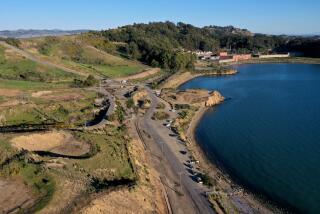Losing His Hold on the Precious Land : Staten Island: A serene, wooded settlement that’s been one man’s home for nearly 88 years is scheduled to make way for tennis courts.
- Share via
NEW YORK — Louie Bernhardt has lived on a beachfront patch of property in a serene, wooded settlement of Staten Island for nearly all his 88 years.
The patch is next to a 300-acre city park. Though the city condemned his property in 1975, Bernhardt stayed.
In the two decades since, he’s watched neighbors move away, seen their houses burned by teen-age thugs. Still, he stayed.
Not even Mother Nature and her brutal winter nor’easter that gobbled up his wooden pier in 1992 could persuade him to leave.
“I love this place,” he said, gazing into the lapping Atlantic waves from the weatherworn deck he built plank by plank. “I can sit and watch it all day.”
But not for long.
Twenty years after the city bought Bernhardt’s corner of the world--20 land acres and 50 under water--it finally has a plan to use it: tennis courts.
“It wouldn’t be so bad if they really needed it,” Bernhardt said. “They say it’s progress, but I don’t call knocking down homes progress.”
One can understand Bernhardt’s feelings standing among the trove of pretty tulip trees, sweet gums and towering oaks that will be plowed through to make way for a pedestrian path and tennis courts.
The dirt road in front of Bernhardt’s home on Belle Drive leads to a neighbor’s garden brimming with corn stalks 7 feet tall and green tomatoes plumping up on leafy vines.
Alone in the calm of the woods--birds singing and sunlight peeking through the trees--it’s hard to remember that this is New York City.
Bernhardt is a retired sign hanger. Sitting on his deck, shirtless and suntanned, white whiskers sprouting over his face, he looks every inch the old salt.
He says he has stayed because he didn’t believe the city would ever use the land. After the land was condemned, the city decided what it was worth and paid the families living in the nearly 40 trim little bungalows varying amounts of money.
Bernhardt’s 20-by-165-foot swatch of land extends into the water where the remains of his storm-torn pier still stand. He got $15,000.
“It’s not like I had a choice. They said, ‘We want this. This is what you’re getting.’ End of story.” He said he could have hired a lawyer to fight but, “I distrust them even more than politicians.”
There was talk of knocking down the colony to build a road around the island, the city’s least populous and most suburban borough.
“It was still the Robert Moses kind of thinking,” he said, referring to the master public works builder responsible for much of the city’s modern highway system, which was often built by plowing through--some say destroying--neighborhoods.
Then a fiscal crisis hit and the city nearly went bankrupt. Plans were shelved, but the land remained in city hands “for future park use.”
Bernhardt watched as most of the original tenants moved away. Abandoned bungalows soon became nighttime haunts for partying teen-agers and often were burned down, or left in ruins.
Today, only 10 homes remain. Bernhardt and three other full-time residents, including Bernhardt’s 52-year-old son who lives three doors away, pay the city a few hundred dollars a month to remain in their homes.
A few others--including the neighbor next to Bernhardt with a “Papa Joe’s Ragin Cajun” sign on his patio--use the bungalows on weekends.
Philip Fitzpatrick, a 32-year-old lawyer who looks after his cousin’s Belle Drive place, says when the bulldozers come “another little piece of serenity will be lost.”
“People pretty much keep to themselves down here,” Fitzpatrick said. “That’s why they’re here, I think--for the peace.”
But none has the connection to the land that Bernhardt does.
“My father built this place in sections,” Bernhardt said, “carrying pieces of other bungalows that were knocked down to make way for Wolfe’s Pond,” the neighboring city park.
He’s been on the same piece of property since the early 1920s. “Our first home was a 16-by-16 Army tent.”
He grew up in the bungalow with his father, mother and a sister. After renting for years, Bernhardt bought his land from a local holding company in 1945 for $2,000.
In his working years, he lived part time in Brooklyn, coming back to the bungalow weekends and summers. He came for good when he retired in 1975.
His daughter and three sons were practically reared here. Though still married, Bernhardt’s wife lives elsewhere on the island.
“I’m not a mixer. The children come and visit sometime with the grandkids.” But most of his days are spent alone, with only the company of his four cats.
An avid gardener, he used to spend the days tending to his vegetable garden full of potatoes, string beans and corn. His son does most of that now. “The legs are too bad,” he said.
“But there’s always something to do. Feed the cats. Feed the birds. Drink a couple of beers. Drink a couple more beers.”
But the bulldozer’s roar is not far away.
The $1.5-million project is in the design stage, said Staten Island Parks Commissioner Thomas Paulo. Construction is set to begin in the fall or spring of 1997.
“It’s getting close to the time when it will happen. It’s no longer a question of if,” Paulo said, adding that the city is aware it will be difficult for people like Bernhardt to leave.
“I’m sure the city will try to make the process as comfortable, as painless, as possible in terms of relocation,” Paulo said.
More to Read
Sign up for Essential California
The most important California stories and recommendations in your inbox every morning.
You may occasionally receive promotional content from the Los Angeles Times.













